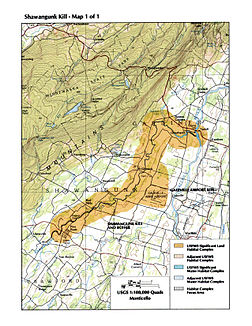Shawangunk Kill
| Shawangunk Kill | ||
|
The Shawangunk kill in the section where it forms the border between Orange and Ulster Counties. |
||
| Data | ||
| Water code | US : 964981 | |
| location | New York (USA) | |
| River system | Hudson River | |
| Drain over | Wallkill River → Rondout Creek → Hudson River → Atlantic Ocean | |
| source |
Town of Greenville, New York 41 ° 23 ′ 35 " N , 74 ° 36 ′ 8" W. |
|
| Source height | 378 m | |
| muzzle |
Wallkill River west of Gardiner (New York) Coordinates: 41 ° 41 ′ 1 " N , 74 ° 9 ′ 54" W 41 ° 41 ′ 1 " N , 74 ° 9 ′ 54" W |
|
| Mouth height | 55 m | |
| Height difference | 323 m | |
| Bottom slope | 5.8 ‰ | |
| length | 56 km | |
| Catchment area | 380 km² | |
| Drain |
MQ |
3.9 m³ / s |
|
The US Fish and Wildlife Service has designated a habitat on the river |
||
The Shawangunk Kill is the largest tributary of the Wallkill River .
It flows northeastward and forms on part of its course the northwestern boundary between Orange County and the Sullivan and later the Ulster County in New York in the United States . The name of this 35 miles long river is derived from the Shawangunk Ridge , where the river in the Town of Greenville has its source.
Run
From its source in Greenville, the river always strives northeast to Mill Pond near Mount Hope , upon reaching which it has already lost almost half of its source height. It flows through fields and forests east of Otisville . In the hamlet of New Vernon it becomes the county border between Orange and Sullivan Counties. A little later, the first named tributary flows in, the Little Shawangunk Kill.
It expands a little at Bloomingburg . North of this town, New York State Route 17 crosses the river; it is the busiest road on the river. A few kilometers further north, the confluence of the Platte Kill is the point at which Sullivan County is replaced by Ulster County. From this point the river bends slightly to the east.
Then the water reaches Pine Bush on the east bank and a few miles further the Shawangunk River completely enters Ulster County, at the northernmost point of Orange County. The river meanders through the ever widening valley, which is mainly used by farms and woodlots. The mountain range continues to rise on the western horizon. Eventually the river bends east and joins the Wallkill River south of US Highway 44 / New York State Route 55 at Gardiner .
Natural history
In the early 1990s, the United States Fish and Wildlife Service investigated the impact of the former Galeville Air Force Base - now the Shawangunk Grasslands National Wildlife Refuge - and found that the lower reaches of the river between its estuary and Pine Bush were the habitat of an unusual variety of Plants and animals is. The reason is the lack of dams on the upper reaches. Six species of freshwater bivalve molluscs have been identified, including the rare Alasmidonta varicosa , as well as 31 species of fish, including the carp Leuciscinae Notropis amoenus and Notropis stramineus , the perch Percina caproedes , the sunfish Lepomis auritis, and the catfish Noturus insignis .
The area has been found to be the only known occurrence of Diarrhena obovata sweet grass in New York State. Other rare plants in the lower reaches are the Malpighienartige Podostemum Ceratophyllum on the submerged rock edges Gauklerblume Mimulus alatus and the Cyperus Cyperus erythrorhizos the river itself and the sedge Carex davisii that Odermennige Agrimonia parviflora , the Aster Aster vimeneus and Schmetterlingsblütler Lespedeza violacea on the fields in the flood plain of the river.
Due to the poor development - mostly of an agricultural nature - in the catchment area, the river is only very slightly polluted with pollutants.
geology
The basement at the Shawangunk Rivers consists mainly of clay slate , which is covered by silty clay soils that were formed in the last ice age. The river bed itself varies between rock, scree, sand and clay. Geologically, the Shawangunk Valley is part of the Ridge-and-Valley Appalachians , which is bounded to the west by the Shawangunk Ridge and to the east by the lower Hoagerburgh Ridge .
Tributaries
Individual evidence
- ↑ Shawangunk Kill in the Geographic Names Information System of the United States Geological Survey
- ↑ a b c d Shawangunk Kill ( English ) United States Fish and Wildlife Service . Retrieved February 27, 2009.

